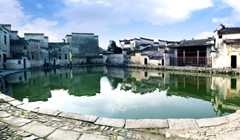Line Two: Famous mountain blessing Tour
 Introduction of the spots
Introduction of the spots
|
Anhui’s mountains and water have a historical spirit associated with it. Tianzhu Mountain impresses visitors with its grand appearance and the powerful force it strikes in their hearts. Sikong Mountain’s charm rests in embodying the persistence of Zen which has the ability to touch the bottom of your heart. Temples and Buddhist activities can be found on Jiuhua Mountain, at the same time bringing peace to your heart. Qiyun Mountain was credited as second-to-none by Qianlong, an emperor in the Qing Dynasty. Mountains in Anhui are the best places to go when praying for blessings. |
★ Jiuhua Mountain Scenic Area ★
Jiuhua Mountain, which was formerly called Jiuzi Mountain, is located in Qingyang county, Chizhou city, 20 km southwest of the county seat. It covers an area of 120 square km. With connected mountain peaks and various unusual stone formations, Jiuhua Mountain consists of 99 peaks, numerous brooks, waterfalls, secluded caves and strangely-shaped pine trees. All of these contribute to the fresh and natural landscapes.
Jiuhua Mountain is a famous historical and cultural mountain. More than 20 academies of classical learning have been successively established here since ancient times, including the Taibai, Teng Zijing and Yangming academies. There are over 2,000 extant cultural relics, and here too you can find 500 or so poems and essays by famous writers and scholars from all previous dynasties.
With its numerous ancient temples, Jiuhua Mountain is one of the four great Buddhist Mountains in China. Of the 99 extant temples, nine are at national key level and 30 are provincial key sites. Jiuhua Mountain has over 1,000 monks and nuns and more than 10,000 Buddhist statues preserved from all previous dynasties, hence the name the Land of Buddha with Lotus Flowers. Thanks to the strong and mysterious atmosphere of Buddhism and the wide-ranging and profound Ksitigarbha culture, it has attracted tens of thousands of visitors both from home and abroad, and remains an important international center for the performance of Buddhist rites.
★ Tianzhu Mountain Scenic Area ★
Tianzhu Mountain is located in Qianshan county. Its highest peak—Tianzhu Peak (1,488.4 meters above sea level)—rises high into the clouds, just like a pillar holding up the sky, hence the name Tianzhu (Heavenly Pillar) Mountain. It is a key national scenic and historical interest site, a national forest park and a national geological park.
The scenic area covers an area of 82.46 square km and consists of eight different parts. The scenery in the mountain, combining the loftiness of the mountains north of the Yangtze River with the delicacy of the mountains to the south, can be portrayed as "mighty peaks, queer rocks, tranquil caves and emerald water". There are 42 peaks, each covered by green pines and slender bamboos and strewn with strangely-shaped stones, mysterious caves, flying waterfalls and deep pools. Besides the picturesque natural views, it is also rich in historical sites. They include the Mysterious Valley (known as "the first granite mysterious place"), the Sanzu Temple (the ancestral temple of the third generation of Chinese Zen), petroglyphs in the Ancient Shiniu Cave (i.e. Stone Cattle Cave, known as a wonder of the world), drifting on the Qianhe River (known as "the first drifting on the Yangtze-Huaihe rivers") and Liandan Lake (the third largest man-made mountain lake of China).
★ Sikong Mountain Scenic Area ★
Sikong Mountain is 40km away from the west of Yuexi county. It is named after Chunyushi, who was known as Dasikong in late the eastern Zhou but had later gone to live as a hermit in the mountains. Sikong Mountain was named “the No.1 in Chinese Zen” for Huike, the second master of Chinese Zen, who had set his rite here.
★ Qiyun Mountain ★
Located in Xiuning county, Qiyun Mountain faces Huangshan Mountain in the south. It is a national key scenic and historic interest zone, a national forest and a national geological park. Its highest peak, Langya, "penetrates the sky, and is as high as the clouds", hence the name Qiyun (meaning it is as high as the cloud) Mountain. According to historical records, the top of the mountain was always enveloped in white clouds, so it was also known as the White Mountain.
Covering an area of 110 square km, the Qiyun Mountain Scenic Area mainly consists of three parts: Yuehua Street, Yunyan Lake and Loushanglou Building. It is famous for its steep mountain, clear waters, oddly shaped stones and tranquil caves. There are 36 steep peaks, 44 oddly shaped rocks, 18 tranquil caves, 27 waterfall caves of springs, 14 pools, 16 pavilions and terraces, 537 inscriptions and stone tablets, three decorated stone archways, five stone bridges and 33 temples and nunneries. It is a mountainous scenic area with the characteristics of Taoist culture, being a place where Taoism and Buddhism blend with each other.
Editor: Li Jing

 What's so special about the line
What's so special about the line

